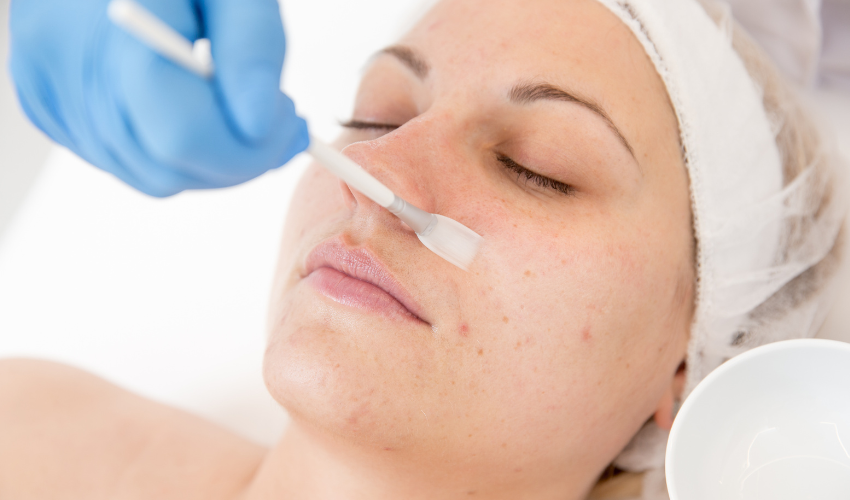Our skin is the largest organ in the human body and serves as the first line of defense against the harsh environment we live in. Over time, it is exposed to various pollutants, UV rays, and other harmful factors that can damage it, leading to dullness, pigmentation, acne, and other skin problems.
Luckily, skin peels are here to save the day! They can help you achieve that youthful and radiant complexion you’ve always wanted. In this article, we will take a closer look at the different types of skin peels and how to use them to get the best results.
Types of Skin Peels and How to Use Them

Glycolic Acid Peel
Glycolic acid is derived from sugar cane and is the most popular type of alpha-hydroxy acid (AHA) peel. It works by breaking down the top layer of dead skin cells, revealing fresh, new skin beneath.
- Apply a thin layer of the glycolic acid peel solution to your face, avoiding the eye area and lips.
- Leave it on for 1-2 minutes, then rinse it off with cool water.
- Start with a low concentration and gradually increase as your skin adjusts.
Salicylic Acid Peel
Salicylic acid is a beta-hydroxy acid (BHA) that is perfect for those with oily and acne-prone skin. It works by penetrating deep into the pores and unclogging them, reducing oil production, and preventing future breakouts.
- Apply the salicylic acid peel solution to your face and neck, avoiding the eye area and lips.
- Leave it on for 5-10 minutes, then rinse it off with cool water.
- Use it once or twice a week for best results.
Lactic Acid Peel
Lactic acid is a gentle AHA peel that is perfect for those with sensitive skin. It works by exfoliating the top layer of dead skin cells and promoting cell renewal.
- Apply a thin layer of the lactic acid peel solution to your face, avoiding the eye area and lips.
- Leave it on for 2-5 minutes, then rinse it off with cool water.
- Use it once a week for best results.
TCA Peel
Trichloroacetic acid (TCA) is a medium-depth peel that can help reduce fine lines, wrinkles, and pigmentation. It works by removing the outer layers of damaged skin, revealing fresh, new skin beneath.
- Apply a thin layer of the TCA peel solution to your face, avoiding the eye area and lips.
- Leave it on for 5-10 minutes, then rinse it off with cool water.
- It is recommended to use this peel once a month for best results.
Jessner’s Peel
Jessner’s peel is a combination of lactic acid, salicylic acid, and resorcinol. It is a medium-depth peel that can help reduce pigmentation, fine lines, and wrinkles.
- Apply a thin layer of the Jessner’s peel solution to your face, avoiding the eye area and lips.
- Leave it on for 5-10 minutes, then rinse it off with cool water.
- Use it once a month for best results.
FAQs
Are skin peels safe?
Yes, skin peels are generally safe, but it is essential to follow the instructions carefully and start with a low concentration if you’re a beginner. Also, it is crucial to avoid overusing them and to give your skin time to heal between peels.
How often should I use a skin peel?
The frequency of use depends on the type of peel and your skin type. As a general rule, it is recommended to use them once or twice a week for gentle peels like salicylic or lactic acid and once a month for deeper peels like TCA or Jessner’s peel.
Can skin peels cause skin irritation?
Yes, they can cause skin irritation, especially if you have sensitive skin or use them too frequently. It is essential to do a patch test before using a new peel and to follow the instructions carefully.
Can skin peels help with acne?
Yes, skin peels like salicylic acid peel can help reduce acne by unclogging pores and reducing oil production. However, it is essential to consult with a dermatologist before using any peels if you have severe acne.
Can I use a skin peel if I have dark skin?
Yes, skin peels can be used on dark skin, but it is essential to be cautious and avoid using peels that are too harsh, as they can cause hyperpigmentation. It is recommended to consult with a dermatologist before using any peels if you have dark skin.
Conclusion
Skin peels are an excellent way to achieve youthful and glowing skin by removing dead skin cells and promoting cell renewal. However, it is crucial to choose the right type of peel for your skin type and to follow the instructions carefully to avoid skin irritation or damage. By using the types of skin peels and how to use them as a guide, you can achieve that healthy and radiant complexion you’ve always wanted.























